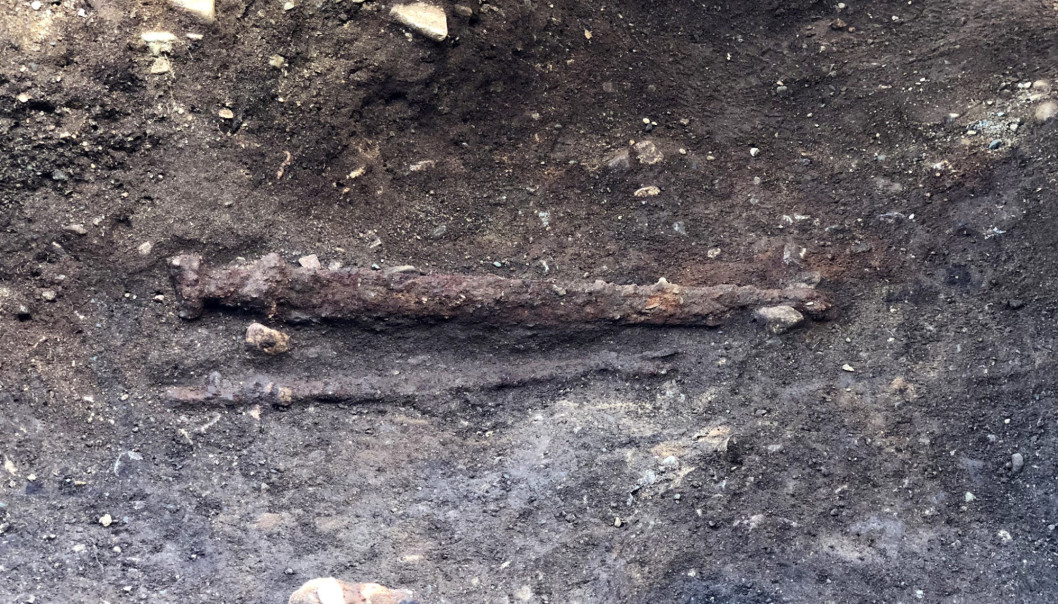Viking sword placed on warrior's left side likely prepared him for 'mirror afterlife'
The 1,100-year-old steel sword is nearly 3 feet long.

Archaeologists in Norway have unearthed the 1,100-year-old grave of a Viking warrior, whose steel sword was placed in an unusual spot: on his left side.
Though the sword's sinistral position is still somewhat perplexing, one theory is that the Vikings perceived the afterlife to be a mirror image of the real world, so whoever buried this warrior may have been accounting for that, said Raymond Sauvage, the excavation's project manager and an archaeologist at the Norwegian University of Science and Technology (NTNU) University Museum. According to that theory, the warrior would have been left-handed and worn the sword at his right hip, so the 2.6-foot-long (80 centimeters) sword was simply buried on what would have been his "mirror" side, Sauvage said.
"Usually, the swords in Viking graves are placed on the right-hand side," Sauvage told Live Science in an email. "Normally, a warrior would [fasten] his sword on the left side" so that it could be pulled out by the right hand. This discrepancy — that is, that Vikings buried their swords on the opposite side of the body from where weapons were typically worn — has led some archaeologists to think that the Vikings believed in a "mirror world" afterlife.
Related: Photos: 10th-century Viking tomb unearthed in Denmark
"The idea is that this placement must reflect some beliefs that were important in the mortuary rites," Sauvage said, adding that "other [Viking] items are often found to be placed mirrored of what is normal. Several archaeologists therefore believe that this may reflect a belief that they understood the afterlife to be mirrored of the normal world."
The Vikings weren't alone in this mirror-afterlife belief. "This is a notion that exists in several beliefs and religions, across time and space," Sauvage said.
Buried together
Archaeologists found this Viking grave and others ahead of a road construction project in the village of Vinjeøra, in central Norway. So far, excavation teams have found about 10 burial mounds that contain roughly 20 graves, including those of two mortuary houses and three boat graves, which were excavated in 2019. The new excavation revealed that one of the mounds held three graves: the warrior buried with the left-placed sword, as well as a spear, axe and shield boss (the round material, usually made of heavy metal, at the center of the shield); a grave with a broad axe; and a cremation burial with artifacts usually associated with female burials, including an oval brooch, scissors and beads.
Sign up for the Live Science daily newsletter now
Get the world’s most fascinating discoveries delivered straight to your inbox.
"We do not know their exact relation and chronology yet, but we will figure this out during our study of the find," Sauvage noted. However, these three buried individuals are likely related, he said. "At Vinjeøra, we see that burials were often reused, and it was important to lie close to ancestors." In Norse society, ancestral worship was an important part of everyday life, "and we believe this may be reflected in this way of reusing graves across centuries, and situating them close together," he said.

The team has already gathered a few details from the sword burial. "The fact that he was buried with a full set of weapons tells us that this was a warrior, and in Viking times and the early Middle Ages, most warriors were free men who owned their own farms,” Sauvage said in an NTNU statement.
Related: Images: Viking-age jewelry revealed in sparkling photos
This interpretation fits with the site, which was a farm during Viking times, which lasted from the late eighth to early 11th century. "The law in the Middle Ages dictated that a farmer had to procure weaponry," Sauvage continued. "First, you were required to get an axe and a shield, and eventually you could also have a spear and a sword."
A study of the cremated remains is ongoing, but will hopefully reveal the individual's age, sex and any physical signs of maladies.
The cremated remains are heavy, at least several pounds, which is unusual in Viking culture. "A study done several years ago showed that cremation graves from the Iron Age, on average, contain only about 250 grams [0.5 lbs.] of bone," Sauvage said. "A dead human body that is cremated, on the other hand, burns down to about 2 kilos [4.4 lbs.] of bones."
In the old Viking sagas, ancestral bones were viewed as having magical properties, such as giving people strength and curing illness, Sauvage said. Perhaps these "missing" bones were used for those purposes, he said. In this case, all of the woman's remains appear to be present, based on the cremation's weight, although the archaeologists also found some bird bones in the burial.
The team plans to finish the excavations, which are being financed by the Norwegian Public Roads Administration, this fall.
Originally published on Live Science.

Laura is the archaeology and Life's Little Mysteries editor at Live Science. She also reports on general science, including paleontology. Her work has appeared in The New York Times, Scholastic, Popular Science and Spectrum, a site on autism research. She has won multiple awards from the Society of Professional Journalists and the Washington Newspaper Publishers Association for her reporting at a weekly newspaper near Seattle. Laura holds a bachelor's degree in English literature and psychology from Washington University in St. Louis and a master's degree in science writing from NYU.










